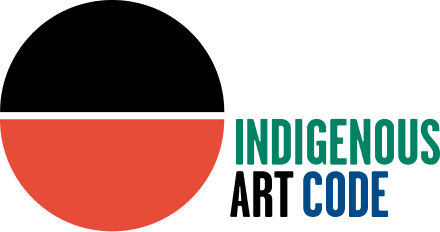UNIQUE ARTWORK. MEANINGFUL GIFTS.
Koh Living is proud to work closely with Indigenous Australian artists, showcasing their unique and vibrant artistry through our range of exquisite products. This collaboration is more than just a partnership; it's a celebration of the rich cultural heritage of Indigenous Australians and a way to share their stories with the world. At Koh Living, we offer you a wide range of high-quality Aboriginal art products that are both beautiful and culturally significant.
Explore beautiful, authentic Aboriginal art giftware showcasing art from our partnered artists. Each artwork carries a unique narrative, reflecting connections to the land, ancestral traditions, and spiritual heritage.
Our ethical Aboriginal art products are a celebration of Indigenous heritage, showcasing traditional techniques, patterns, and symbols that have been passed down through generations. Whether you're searching for a special gift for a loved one or simply want to indulge yourself, we at Koh Living have something for everyone.
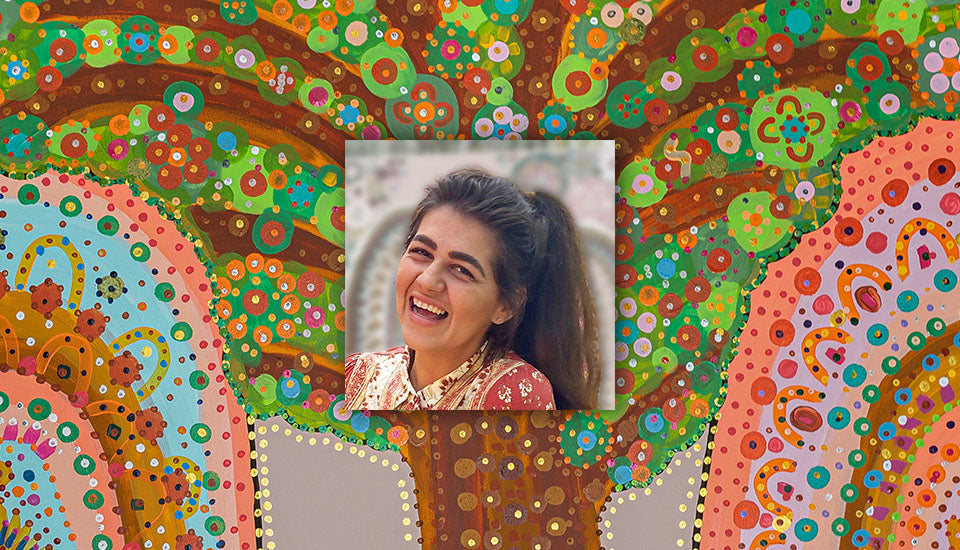
About Jacinta-rai Ridgeway
Meet Jacinta-rai Ridgeway
Jacinta-Rai Ridgeway-Maahs is a proud Worimi woman, telling stories through art, just as her ancestors did. Jacinta-Rai, whilst always being surrounded by her family's art, didn't start painting herself until she was twenty-eight. Now, this emerging indigenous artist is unstoppable, and her style is Aboriginal contemporary. Inspired by trees, waterways, rainbows, ocean, sun, wildlife, her children and ancestors, every piece of her art tells a story.
Created in Butchulla country, Jacinta-Rai embraces the earthy tones, peachy pinks, pastels, and bold colours of South East Queensland to create vivid depictions of country, community, culture and family. Her art is uniquely Indigenous and, at the same time, universal to the human experience. Jacinta-Rai’s art is a visual meditation - there is a quiet relaxation that comes with every symbol, dash and dot.
Artwork & Story
Each of Jacinta-Rai's designs tells a story.
Together Again
‘Together Again’ tells the story of two people who are briefly separated; one passes away, but they are reunited once more in the Dreaming. Together, they reflect on the beautiful life they shared as they watch over their loved ones. Two rainbows symbolise how every experience strengthens their relationship. The colourful surroundings represent the legacy and memories shared with family as they grew and walked together through the Country.
Home
‘Home’ represents the way we find our path and walk life’s journey in the Country. As individuals, we each contribute to the rich tapestry of community – all different yet equally essential for a balanced environment. It shows that we can walk together in unity and harmony, we can truly make a difference for generations to come.
Journeys in the Sun
‘Journeys in the Sun’ tells of her Worimi people’s experiences as they travelled across the Country. The circles represent various mobs, yarning with their young, teaching them how to survive using the sun, sky and sea. The tracks connect individual mobs and show how they come together in times of celebration or need.
Tree of Life
This design depicts the journey of life; all that we were, are, and will one day be. The past is inseparably tied to the Country. Our ancestors understood the need to know and love the land that gave them life, and this echoes through to the present. Today, we find solace in connecting to the Country, sharing knowledge and storytelling. The ‘Tree of Life’ design then turns to the future as we dream of the endless possibilities that life affords to each of us.
We Are One
Inspired by the colours of the AIATSIS Map of Indigenous Australia. We are One represents our First Nations people’s and the different mobs we come from all around Australia.
It represents how even though we come from different mobs around Australia we strive to work and walk together as one.
It symbolises the country on which we live, love and learn on. It represents and acknowledges our First Nations peoples being the traditional owners of this land. Always was, Always will be.
Girambit
The rainbow in this piece represents the many Ngurras (our clan groups) that form our community. The deep blue circles symbolise
the coming together to care for our waterways and abundant ocean life. Educating our future generations of lessons learnt through time and the importance of community respecting all that mother earth has provided. The soft circles , golds , greens , coral and yellows show how for generations our Worimi people/ salt water people , have maintained close connections with land and sea - protecting all that it embraces to ensure a healthy, vibrant and sustainable future for all Ngurras and their respective mobs across country.
Creation
The main wave across this piece represents the beginning, the wave of time from which all things are created- where our story starts. Below the wave we have the beautiful blues and greens signifying the importance of water, our oceans and rivers and how it is essential for every life form in order to exist, adapt and flourish.
The white, creams and peaches show how through creation we connect communities working together in order to survive
and thrive. Our land and peoples are symbolised through the rainbow’s connection to the wave of time with each run in the rainbow sharing our story from the time of creation as we grow and evolve.
Where we have been, where we are today and where we are going – Our past, our present, Our future.
Infinity
Infinity symbolises a parent and guardians infinite love for their family. Infinity means forever, with out bound, has no end, unlimited- just like a parents/carers love.
It signifies the incredible impact they have on their child’s life and the strong imprint they leave on their child’s heart forever.
Making beautiful memories, helping each other up when they are down, being each others safe meeting place and continually growing together.
Her Journey
Representing her inner peace and the path she takes as she embarks on her individual journey through life, she stays grounded as she guides and protects those around her, giving them strength and reminding them of the importance of believing in and achieving their dreams. She is the symbol of mother earth and the circle of life who nurtures spiritual development and fosters wisdom, patience and determination as she navigates life’s challenges.
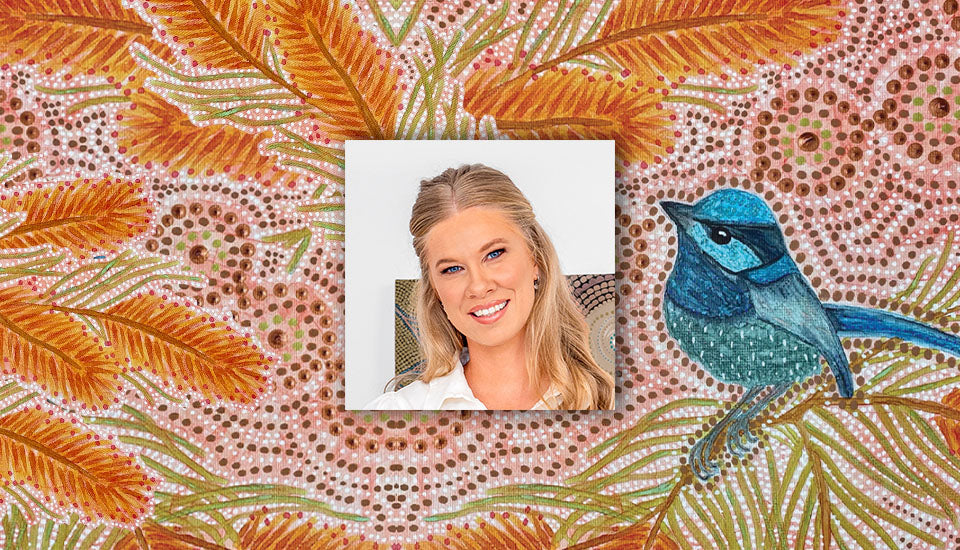
About Domica Hill
Meet Domica Hill
Domica Hill's story is one of loss and hope, with painting being at the front of centre of her healing process. Domica moved to Victoria in 2015 where she felt more accepted as an Aboriginal woman of Palawa Ancestry and was inspired to paint following the loss of her daughter and subsequent miscarriage.
Domica credits painting as key to her journey of healing and creating hope for the future, with the birth of her son and meeting many people with whom painting their stories has helped with their grief. Read more here in our blog.
Artwork & Story
Luina - The Blue Wren
This piece represents the Tasmanian Aboriginal story of Dromerdeene,who, seeking reconciliation with his brother Moihernee, is attacked by
Moihernee’s beasts. A tiny grey bird overhears the beasts’ plan, valiantly tries to protect Dromerdeene, and is thrown against a tree. Other bush
creatures join the fight, a bright star rescues Dromerdeene, and in gratitude, he bestows unique attributes upon the bird—Luina, the blue wren, including bright black eyes, a fan of feathers, and a crown of beautiful blue, symbolizing courage and freedom.
Kookaburra Dreaming
This piece shows a Kookaburra sitting in a Gum Tree looking out over all the meeting spots on country. He looks over the ceremonies and healing that
takes place here and watches as the community come together in celebration.
Spirit Being
This piece represents our spirit being in the form of a Galah. Birds are very important to Aboriginal people and are often seen as totemic ancestors and
spirit beings. The painting shows a Galah perched up on the branch of a flowering gum. There is a path/track running through the middle of the piece
with many meeting places and rest stops. This represents your journey with the spirit being looking out for you along the way.
Kunanyi’s Pink Robbin
Kunanyi is the Palawan Kani name for Mount Wellington.This piece depicts that there is beauty in everything around us. Aboriginal culture is rich with
stories that celebrate the beauty of nature and its creatures. Kunanyi’s pink robin is not shy like usually seen in this native species. He loves to look at his reflection and admire his own beauty. The artwork shows the beauty in the country, the flora and the fauna while embedding culture with dot art throughout.
Flowering Gum
This piece shows a flowering gum in bloom. It is a reminder that each season brings new life, new blooms and acts as a new beginning in some way.
Proteas
This piece represents acceptance of others to our country. The protea is not native to Australia however has become accepted like the many cultures now becoming a part of our history. It is a reminder that we need to grow as a
country and become more diverse in seeing the beauty of all cultures.
Waratah Flame
The waratah leaves are known to protect us from fire and great heat.
This piece depicts the flower shielding us from the flames of the negativity surrounding us. It is a reminder to stand tall in the hard times.
Desert Pea
This piece represents ‘Ngooringa’ which is the Aboriginal name for the Sturts desert pea. Based on a story about a girl who fell ill after falling in love with a member of another tribe. In the story she died from the illness but her spirit returned as a beautiful desert flower.
Banksia
This Banksia represents the symbol of rebirth and new beginnings. The Banksia flower reaches out to embrace the warmth of the sunlight.
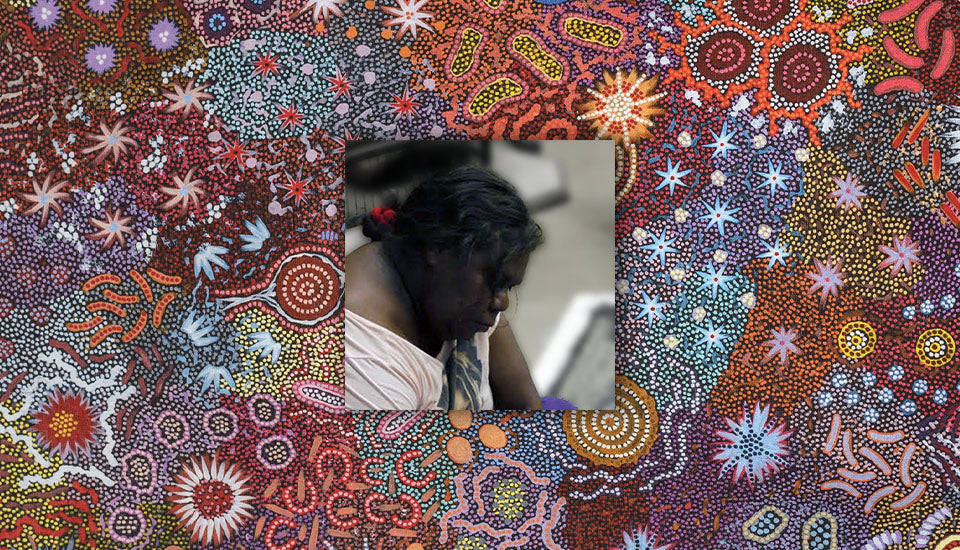
About Michelle Possum
Meet Michelle Possum
Michelle Possum was born at Napperby Station, Northwest of Alice Springs in the Northern Territory. She was taught to paint by her father Clifford Possum Tjapaltjarri. Clifford is the most renowned painter of the founding group of Papunya artists.
Michelle’s work has a strong connection to her father, family and land. Her paintings can incorporate strong figurative elements as well as important topography relating to her family's country, such as the abundance of food and water.
Artwork & Story
‘The Dreamings’ that Michelle Possum paints come from Yuelamu in her home country at Mt Allan. These include the stories of Seven Sisters Dreaming, Bush Tucker stories including Seed Dreaming, Bush Coconut, Fire Dreaming, Goanna Dreaming, and Grandmother’s Country, many of which she combines together in complex interwoven designs.
Mainly depicting the overview of maps of traditional Country from her family lands, Michelle describes the many important cultural sites she knows well. Her paintings have gained wide popularity partly due to the fact that as we come to understand the iconography, the paintings make fascinating narratives for a Western audience. They are populated not only with plants and food resources and waterholes, but also with people sitting in the landscape – men with hunting implements and women with digging sticks and coolamons.
In addition to sacred landmarks and iconography, Michelle's artwork includes important bush tucker and waterholes, making a meaningful connection to modern kitchens, the source of such provisions.
Grandmother’s Country
Michelle’s work has a strong connection to her father, family and land. Her paintings can incorporate strong figurative elements as well as important topography relating to her family’s country, such as the abundance of food and water.
Women's Ceremony
In addition to sacred landmarks and iconography, Michelle’s artwork includes important bush tucker and waterholes, making a meaningful connection to modern kitchens, the source of such provisions.
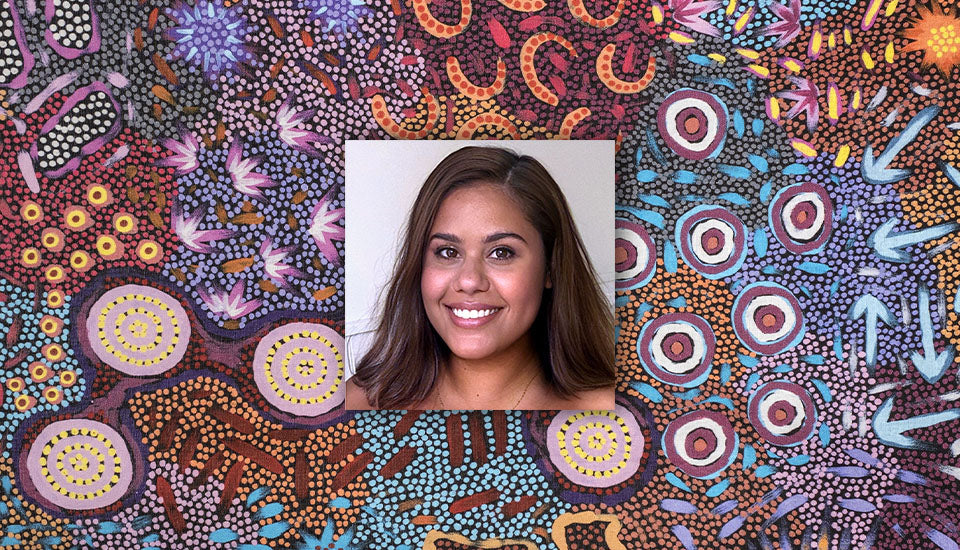
About Khatija Possum
Meet Khatija Possum
Khatija Possum, the granddaughter of renowned Australian indigenous artist Clifford Possum Tjapaltjarri, continues the artistic legacy of her family as a third-generation indigenous art painter. Her father, Heath Ramzan and especially her mother, Michelle Possum Nungurrayi, have played pivotal roles in shaping her artistic journey.
Khatija acquired her painting skills through direct observation and hands-on experience under her mother's guidance. Her mother's art is dedicated to preserving traditional stories and styles, and this can also be seen in Khatija's work.
This process emphasises the integral role of art in the intergenerational transmission of Aboriginal culture and stories. Currently residing in Warragul, Victoria, Khatija lives with her partner John and their children.
Artwork & Story
Each of Khatija's designs tells a story.
Seven Sisters
In the Dreamtime, a group of seven Napaltjarri women were being pursued by a Jakamarra man called Jilbi. He had been sitting in a cave at Irlkirdi practising love magic by cutting off his long hair and weaving it by hand onto a wooden spindle, then performing songs and dances that people from far off could hear. Often, he would entice young women to come to his cave and live with him. Jakamarra men were very proud of their successes when they practised this magic and spent much time boasting about their prowess. The seven women had no intention of sleeping with the Jakamarra man and ran away from him, journeying a long way across the desert until they were too tired and hungry to go any further. They sat down at Uluru to search for honey ants, then when they saw Jilbi approaching. They went to a place called Kurlunyalimpa and changed themselves into seven fires.
With the help of spirits at Uluru, they went up into the sky to become stars. Ever since then, they can be seen as a cluster of seven stars in the constellation Taurus, known as the Pleiades. Jilbi transformed himself into the Morning Star in Orion’s belt and continues to chase the Pleiades across the sky.
Women’s Dreaming
The Women’s Dreaming paintings by Khatija depict Women’s ceremonial sites surrounding Tjukurla in the western desert of Central Australia – traditional homelands to the artist’s great-grandmother. Ceremonial sites carry a deep spiritual meaning, as it is here that the women narrate their sacred Aboriginal Dreamtime stories through song, dance cycles and body paint. This painting has many secret and sacred landmarks and iconography but also includes the important fire, bush tucker and water holes that are imperative to the women, as the ceremonies can last for over a week. Though primarily a landscape painting, Khatija has surpassed the basic stories and landmarks and has expanded this art of body painting and ceremonial themes into a classic contemporary composition using modern acrylic paints.
Salt Water Lake
“This artwork is about Napperby waterholes where my mum would go swimming when she was a child with her family. The water is so pure and fresh you can drink from the waterhole. When it dries up it leaves white salty crystal cracks and if you look closely you can see different colours from them in the sunset.”
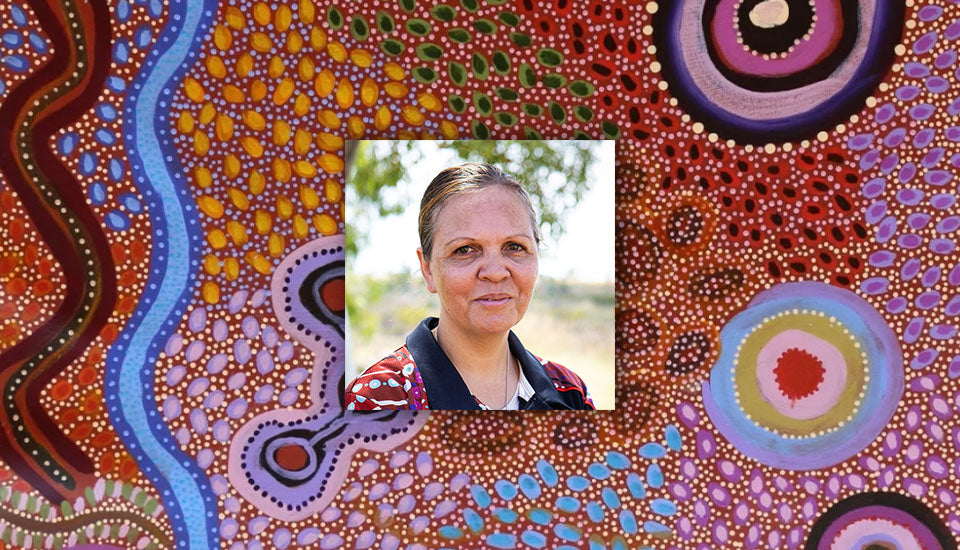
About Justina Willis
Justina Willis was born in Leigh Creek in South Australia in 1981. Her dad was from Adelaide. Her mother was Yindjibarndi from the Millstream Tableland Country and lived in Roebourne. The family moved from Adelaide to Broome and Justina attended primary school and high school there. Her love for art started in high school where she experimented with different styles and art forms. Jusna travelled between Broome and Roebourne a lot and then came to live permanently in Roebourne in about 1999 and has been here ever since.
She started doing art late in 2006 at the back of the Pilbara Aboriginal Church with her family. She went with her young kids and started sketching, drawing and painting. One day someone came and bought an art piece and this inspired her to keep painting.
Artwork & Story
Our Country
In Justina's words, she describes her Our Country artwork:
"Our Country has so much to offer. Bush foods and medicine as well as animals like the kangaroo, emu, goanna and turkey. When the rains come, our rivers are full and we all love to go out and spend the day enjoying the riches of our country. We are connected to our land. It is a part of who we are."
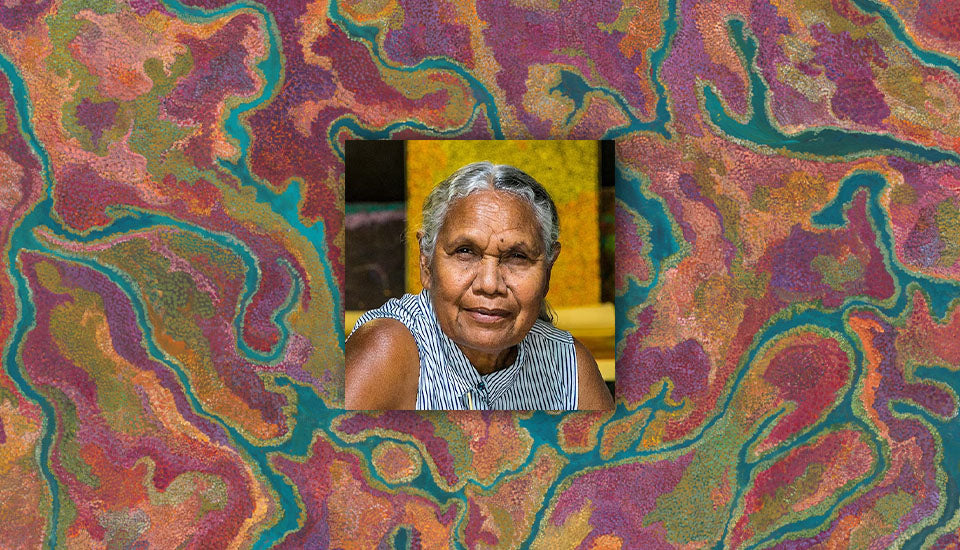
About Allery Sandy
Allery Sandy is a proud Yindjibarndi woman, daughter of Sandy Andrews and Lila King. She was born in Roebourne, the fourth of eleven children and has two daughters and a son.
Allery started painting in February 2006, enrolling in short courses in painting and design. She loves to paint the landscape
of her Country from an aerial perspective. She begins her works with an underpainting using sponge and brush work and then finishes off with a fine layer of dot work, creating a sense of movement and depth
of field on the canvas. Allery also loves depicting the wildflowers of her Country. She enjoys painng the bush seeds, its creeks and rivers, wildflowers in season and trees that are specific to her Pilbara Country. Her style connues to expand and more recently she has started painng aerial landscapes with fine line work on Pilbara earth.
Artwork & Story
Pilbara Creeks
In Allery's words, she describes her Pilbara Creeks artwork:
"During the rainy season many creeks are hidden among the rocky hills of our Country. Big rains bring the animals to come drink from the water and the wildflowers grow again. We love to go fishing on the banks of the creeks, catching many different varieties of fish. Going to places like this is a family day out where we enjoy fishing and cooking and time together just enjoying company with each other. I like to just sit and watch and enjoy the beauty of the place and the smell of the sea. The colours of the creeks blend in with the river sand and paint a beautiful picture of the landscape."
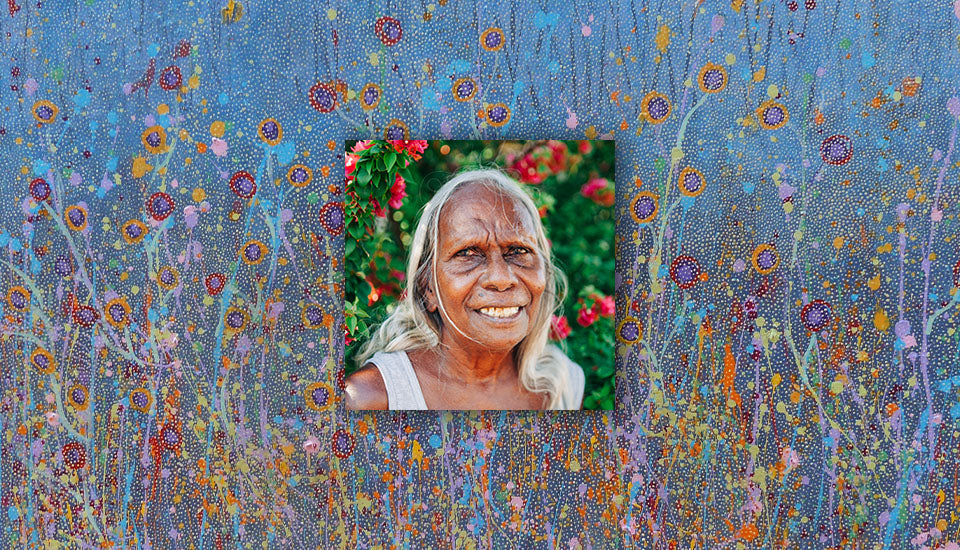
About Marlene Harold
Marlene Harold was born on Mt Florence Station in the Millstream Tablelands. She did some schooling in Nullagine and Marble Bar, finishing her education in Roebourne when her family was moved to the Roebourne Reserve. She has a son, two brothers and a sister.
Marlene started painting late in 2006 at Yinjaa-Barni Art doing a TAFE short course in art and design. A quiet yet active participant in class, she revealed herself to be an enthusiastic socialiser among friends and family, with a witty sense of humour and a strong artistic aptitude. Marlene enjoys learning new techniques and quickly adapts them to her own style. This is reflected in the ease with which she currently moves between styles. Marlene employs a variety of techniques such as dot painng with splaer and sck work to create her artworks.
Artwork & Story
Morning Mist
In Marlene's words, she describes her Morning Mist artwork:
"The wildflowers of my Country bloom in their own time and season. The flowers grow amongst the spinifex grasses and carpet the ground in many colours. They are watered by heavy rains and the early morning mist. The colours in this painting represent the sturt pea flower, the mulla mulla flowers, the wattle and the blue gum flowers."
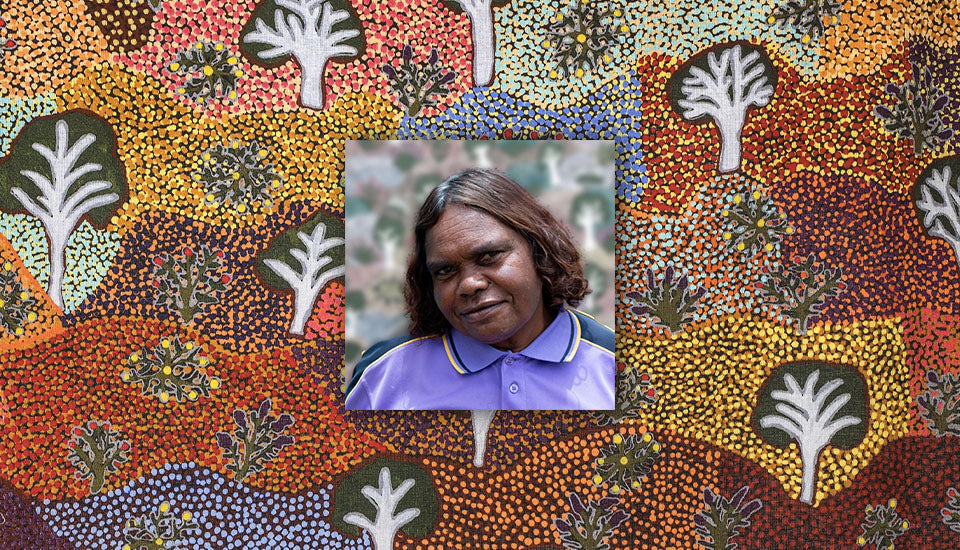
About Annette Nungala
Annette Nungala Peterson was born at Neutral Junction Station, close to Barrow Creek (which is on the Stuart Highway between Alice Springs and Tennant Creek). She spent much of her life working at the Epenarra School, where she dedicated her time to teaching language and culture to young ones. Today, she manages the Epenarra Art Centre.
Annette started painting as a young girl and has re-invigorated this practice in recent years, painting alongside the Epenarra artists of Wutunugurra, where she lives. Her art is influenced by daily life in the community and contains an element of fantasy. Heavy dotting and vivid patchwork colours exaggerate the textures of the pebbled 'rock country' that surrounds her home. Annette paints with a rich, vibrant palette and signature patchwork style, making for dream-like landscapes.
Artwork & Story
Bush Medicine
In Annette's words, she describes her Bush Medicine artwork:
"This painting shows bush medicine after summer rain, and all the little dots represent stones and seeds. When rain time comes, flowers grow again."
Bush Medicine is a subject Annette Nungala Peterson returns to repeatedly in her artworks. Within Indigenous culture, profound importance is placed on the understanding of bush medicine, a knowledge typically entrusted to women. The essence of bush medicine encompasses a connection with Country, familial ties, and a legacy passed down through generations promoting well-being.
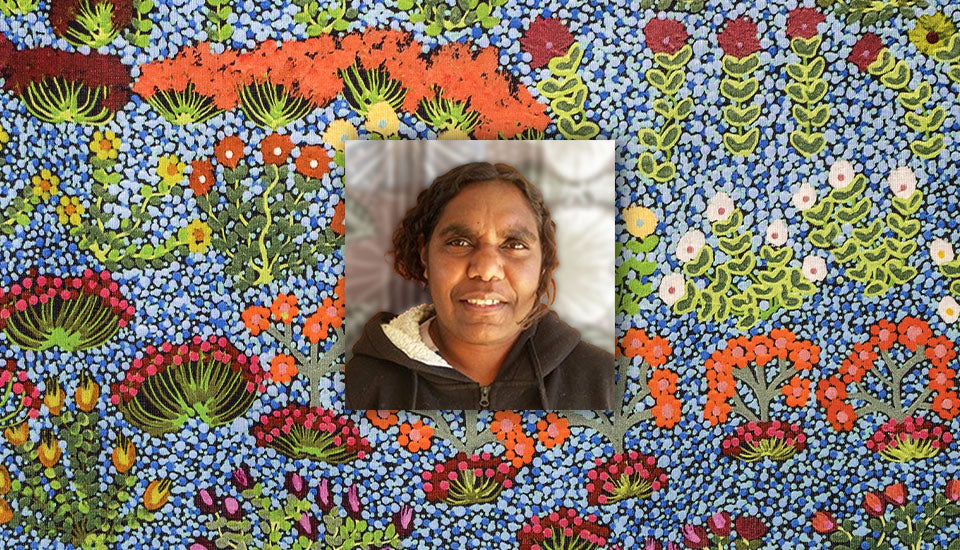
About Pammy Foster
In Pammy's own words: "I like to learn more about my country, my grandmother's country. Painting is the way of learning."
Pammy Foster is an Indigenous artist who paints with the Epenarra Artists Collective. She is a Waramungu and Alyawarr woman born in Tennant Creek and raised between Ampilatwatja and Wutunugurra (Epenarra). She began painting from an early age, learning from her aunt Susie Peterson and her grandmother Jessie Peterson, both well-known artists from Wutunugurra. Pammy paints intricate pieces depicting the bush plants and landscapes of the Wutunugurra region. She is a devoted aboriginal artist who will finesse a canvas until she is completely satisfied with her work, resulting in highly detailed and layered pieces.
Artwork & Story
Epenarra (Blue) & Bush Flowers Blooming (Orange).
"When you go out (into the) bush, you see all different flowers. You can pick them and smell them - some of them smell very nice."
Epenarra design uses bright colours to capture the landscape of the Davenport Ranges. Pammy builds textures with layers of paint, alluding to the rocky nature of the landscape. Densely grouped green trees and flowering bushes cover the canvas, suggesting the work shows the land in the rainy season. Pammy takes an abstract approach to the depiction of Country, and her work captures the rhythm of the landscape with repeated motifs. Wutunugurra (Epenarra) is described by the Indigenous people as Hill Country. It is nestled at the foot of Iytwelepenty (the Davenport Ranges National Park). The area is home to the popular camping sites of Whistleduck Creek and Policeman Waterhole and a unique variety of birds, insects and bush medicine. It is this landscape and environment that Pammy takes her inspiration from.
Wildflowers
“When you go out bush. This is my country, around Karlu Karlu. During winter, yellow flowers everywhere. Swamps.”
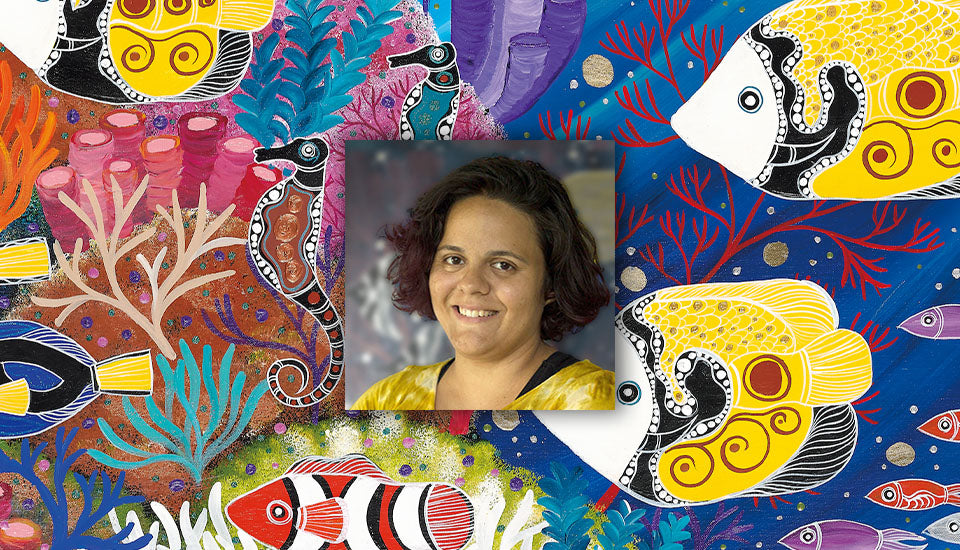
About Melanie Hava
Hailing from the Wet Tropics of Far-North Queensland and identifying as a Mamu Aboriginal woman, Melanie Hava draws continuous inspiration from the reef and rainforest for her artistic creations. Since her early years, Melanie possessed a firm certainty about her destined path as an artist, with art providing her a secure haven.
Meet Melanie Hava
Melanie Hava is one of Tropical North Queensland’s (TNQ) most recognisable First Nations artists. Also named Winden(green pigeon), Melamie is a Mamu woman of the Dugal-barra and Wari-barra clans of the Wet Tropics (the Johnstone River catchment), on her Mother’s side. Melanie also has ancestral heritage to Austria in Europe, in particular the country’s oldest city, Enns; on her Father’s side.
In reflecting the vibrancy of her rainforest and reef, maternal Mamu homelands, Melanie draws inspiration from the storytelling of her people, the landscapes and indigenous flora & fauna. Melainie is a generous artist, inviting audiences into works of great intricacies (and, at times, of large scale) which depict magical and tropical landscapes and marine life tableaux, as well as scenes from red-dirt Country.
With a careful and detailed use of colour and depth Melanie creates glimpses of areas and stories linked to nature which are important to her. Melanie's works bear a hyper-reality quality to them
as she produces artworks which capture the dreams and mystery of her [mostly] untouched Country. In doing so, she is highlighting the fragility of these places due to Climate Change and human encroachment.
Melanie has spent time in Austria (her Father’s homelands), having lived there throughout part of her late teens and early twenties, as well as growing up around the Wet Tropics region. Feeling it important to gain a full understanding of her multicultural heritage, Melanie's works are influenced by Austrian tastes, as well. Hava says that the “architecture and design” of Austria influences her work in crucial ways: "The patterns, gold leaf and occasional Swarovski crystal, in my works are some things that I’ve gleaned from the Austrian side of my heritage”.
Melanie began her practice as an artist when living
in Yowah, Western Queensland. Here, she and her sister Joelene experimented in multiple art forms; in particular painting and imbuing artefacts with visual design elements beyond their craft form. Initially a self-taught expert at composition and applications of various materials, it was here that Melanie began to experiment further in combining her First Nations and Austrian arts and cultural sensibilities into her works. Soon after finding her feet as an artist in 2005 Melanie launched her career as a professional, emerging artist in her first solo exhibition Migaloo Murri, for Outback at Isa gallery (Mount Isa Queensland).
"I’m now settled down in beautiful and inspiring Gimuy/Cairns, close by to my Mother's country. Here, I feel close with the spirit of rainforest and reef animals, and this is coming out in my work” says Melanie.
Melanie is a mother of three, and as well as being an established artists she boasts an incredible string of exhibitions from 2005-2024. Melanie's work is loved by galleries, collectors and art lovers from across the globe.
Artwork & Story
Artwork & Story
My people are the Mamu. Our traditional lands - now internationally recognised as the Wet Tropics of Queensland and the Great Barrier Reef - are both World Heritage Areas. These places and their stories are irreplaceable and priceless to our people, Australia and the world. Sharing and caring about our World Heritage Areas is so important and it is my passion to share these stories through my paintings.
"These paintings are influenced by the landscape of my home, the traditional land of the Rainforest Aboriginal people, right next to the Great Barrier Reef". - Melanie Hava
Utopia Great Barrier Reef
Ever since I read a book about the little mermaid when I was in Primary school, I have loved the mysteries of the ocean’s floor. As I grew older and learnt that The Great Barrier Reef was one of our people’s traditional lands, I was thrilled with the connection. I love to indulge my imagination with scenes of the Great Barrier Reef, a true underwater utopia full of beautiful creatures and fish.
Kinship
This artwork is inspired by the spirit of kinship. Melanie Hava was raised in the outback, where she would often see emus travelling through the long grasses. Occasionally, she would observe two males joining forces to protect their chicks. This banding together in kinship to feed and protect their mob echoes how Aboriginals once lived.
Journey of the Turtle
"The sea turtles remind me of my ancestors, moving around as the seasons dictate, moving for food and moving for nesting/birthing.
Rainforest to the ocean for us and for the turtles from literally oceans to the sands."
Depths of the Dolphin
Again, remind me of my family. Dolphins (and my family) like to hang out together all the time. There’s always a cheeky one there to be the clown and make everyone laugh.



